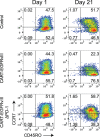CRISPR-Cas9 disruption of PD-1 enhances activity of universal EGFRvIII CAR T cells in a preclinical model of human glioblastoma
- PMID: 31727131
- PMCID: PMC6857271
- DOI: 10.1186/s40425-019-0806-7
CRISPR-Cas9 disruption of PD-1 enhances activity of universal EGFRvIII CAR T cells in a preclinical model of human glioblastoma
Abstract
Despite remarkable success in the treatment of hematological malignancies, CAR T-cell therapies for solid tumors have floundered, in large part due to local immune suppression and the effects of prolonged stimulation leading to T-cell dysfunction and exhaustion. One mechanism by which gliomas and other cancers can hamper CAR T cells is through surface expression of inhibitory ligands such as programmed cell death ligand 1 (PD-L1). Using the CRIPSR-Cas9 system, we created universal CAR T cells resistant to PD-1 inhibition through multiplexed gene disruption of endogenous T-cell receptor (TRAC), beta-2 microglobulin (B2M) and PD-1 (PDCD1). Triple gene-edited CAR T cells demonstrated enhanced activity in preclinical glioma models. Prolonged survival in mice bearing intracranial tumors was achieved after intracerebral, but not intravenous administration. CRISPR-Cas9 gene-editing not only provides a potential source of allogeneic, universal donor cells, but also enables simultaneous disruption of checkpoint signaling that otherwise impedes maximal antitumor functionality.
Keywords: CRISPR-Cas systems; EGFRvIII; Glioblastoma; Receptors, chimeric antigen.
Conflict of interest statement
B.D.C. and M.V.M are inventors on patents related to the use of engineered cell therapies and bispecific T-cell engagers for GBM and other cancers. B.D.C. received commercial research grants from ACEA Biosciences. M.V.M. received commercial research grants from Kite Pharma, TCR2, Agentus, and CRISPR Therapeutics, and is a consultant or advisory board member for Adaptimmune, Agentus, Cellectis, CRISPR Therapeutics, Kite Pharma, Novartis, TCR2, and Windmil (unrelated to this work). H.D., D.B.H., and J.G.S. are employees at CRISPR Therapeutics who possess stock or options in the company.
Figures





References
-
- Stupp R, Hegi ME, Mason WP, van den Bent MJ, Taphoorn MJ, Janzer RC, et al. Effects of radiotherapy with concomitant and adjuvant temozolomide versus radiotherapy alone on survival in glioblastoma in a randomised phase III study: 5-year analysis of the EORTC-NCIC trial. Lancet Oncol. 2009;10(5):459–466. doi: 10.1016/S1470-2045(09)70025-7. - DOI - PubMed
-
- Mullard A. FDA approves first CAR T therapy. Nat Rev Drug Discov. 2017;16(10):669. - PubMed
Publication types
MeSH terms
Substances
Grants and funding
LinkOut - more resources
Full Text Sources
Other Literature Sources
Medical
Research Materials
Miscellaneous
